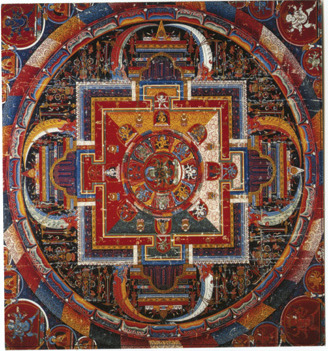An Illustrated Outline of Buddhism: The Essentials of Buddhist Spirituality (27 page)
Read An Illustrated Outline of Buddhism: The Essentials of Buddhist Spirituality Online
Authors: William Stoddart,Joseph A. Fitzgerald
Tags: #Philosophy

viewpoints. In 794, after two years of vigorous debate, the king de-
cided in favor of the Indian monk and his doctrines, and the Chinese
monk was unceremoniously expelled.
Ch’an
Buddhism disappeared
from Tibet, and
Sarvāstivāda
and especial y
Vajrayāna
henceforth
predominated.
In the succeeding centuries, several characteristical y Tibetan
schools of Buddhism developed. The fortunes of Buddhism oscil ated,
but Buddhism in Tibet was given new life in the eleventh century by
the Indian sage Atīsha.
*
* *
One should not be rash or hasty in one’s desire to teach others as
long as one has not realized the truth oneself; otherwise one runs
the risk of being a blind man leading the blind.
Milarepa

90
An Illustrated Outline of Buddhism
ii. The Four Main Schools
The four main schools or spiritual orders of Tibetan Buddhism (along
with their founders and some of the principal figures associated with
them) are as follows:
1. The Nyingma School (eighth century)
The Indian sage Padmasambhava, who had taught at the Buddhist uni-
versity of Nālandā in India, migrated to Tibet, where he founded the
Nyingma
order, which incorporated elements from
Sarvāstivāda
and
Vajrayāna
.
Sarvāstivāda
(see p. 53) may be regarded as a transitional
stage between
Hīnayāna
and
Mahāyāna
.
The followers of this order,
Nyingma-pas
(“Old-style Ones”), are known as “Red Hats”. They are
adherents of the school of “Great Perfection” (
Dzogchen
)
or “Supreme
Yoga” (
Atiyoga
).
The
Nyingma
order—to a greater extent than any of
the other orders mentioned below—also assimilated certain elements
from the older Bön religion.
2. The Sakya School (eleventh century)
Koncho Gyepo Khön was the founder of the
Sakya
(“Gray Earth”) or-
der, which is devoted to the transmission of a cycle of
Vajrayāna
teach-
ings known as
Lamdre
(“Path and Goal”). Amongst its leading gurus
(whom
Sakya-pas
regard as incarnations of Avalokiteshvara) were Sa-
chen Kunga Nyingpo (twelfth century) and Sakya Pandita (thirteenth
century).
3. The Kagyü School (eleventh century)
Marpa and Milarepa were the founders of the
Kagyü
order. Its fol-
lowers,
Kagyü-pas
(“Transmitters of the Word”), are adherents of the
school of the “Great Symbol”
(Mahāmudrā
).
Marpa and Milarepa fol-
lowed the “Diamond Vehicle” (
Vajrayāna
—also known as
Mantrayāna
or
Tantrayāna
),
which they had learned from the Indian masters Ti-
lopa and Nāropa at Nālandā. An off-shoot of the
Kagyü
school is the
Karma-Kagyü
school, whose members,
Karma-Kagyü -pas
,
are known
as “Black Hats”. Their spiritual head is the
Karmapa
.



Tibet
91
4. The Gelug School (fourteenth century)
Tsongkhapa was the founder of the
Gelug
order. The
Gelug-pas
(“Fol-
lowers of the Virtuous Path”) are known as “Yellow Hats”. This order
developed from the much earlier
Kadam
order (“Linked by the Doc-
trine”), which had been founded in the eleventh century by the In-
dian Atīsha.
Gelug-pas
are adherents of the school of the “Middle Way”
(
Mādhyamika
),
which originated in India under Nāgārjuna in the sec-
ond century. This is now the “established” order in Tibet, of which the
Dalai Lama is the spiritual head.1
Vajra
mandala
, Tibet, 16th century
As rain does not break through a well-thatched house, passion
will not break through a well-reflecting mind.
Khuddaka-Nikāya, Dhammapada, 14
1 See Marco Pallis,
Peaks and Lamas
(London: Frank Cass, 1974).






